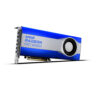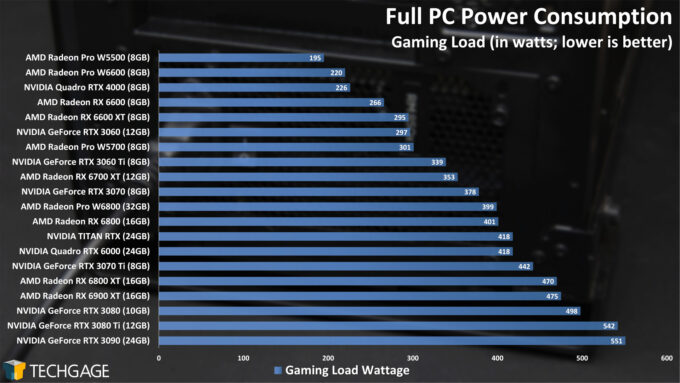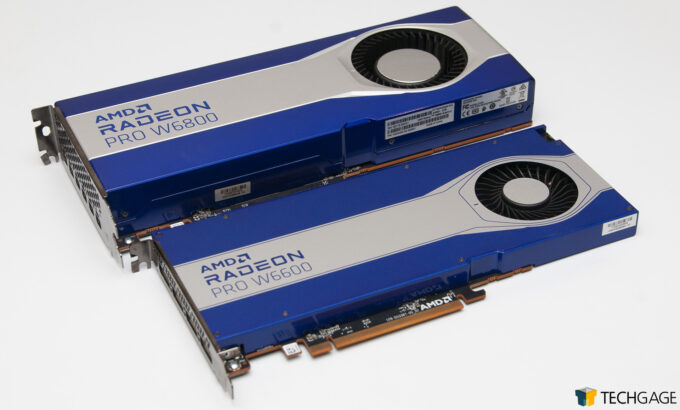- Qualcomm Launches Snapdragon 4 Gen 2 Mobile Platform
- AMD Launches Ryzen PRO 7000 Series Mobile & Desktop Platform
- Intel Launches Sleek Single-Slot Arc Pro A60 Workstation Graphics Card
- NVIDIA Announces Latest Ada Lovelace Additions: GeForce RTX 4060 Ti & RTX 4060
- Maxon Redshift With AMD Radeon GPU Rendering Support Now Available
RDNA2 For Workstation: AMD Radeon Pro W6600 & W6800 Review

AMD has so far released two Radeon Pro models built around its RDNA2 architecture – W6600 and W6800 – and compared to the previous-gen, there’s a lot of improvement. In addition to faster performance in general, we see additions like hardware RT, as well as support for resizable BAR and variable rate shading. Let’s see how both cards fare in our gauntlet of tests.
Page 7 – Power Consumption & Final Thoughts
To take a look at our tested GPUs from a power perspective, we’re using UL’s 3DMark Fire Strike 4K stress test, and our PC plugged into a Kill-A-Watt to monitor full system power draw. The PC is left to sit idle for about five minutes after a fresh boot, at which point the Fire Strike test is kicked-off. The load value is recorded after about five minutes, at the same point in the looped test.
We normally like to include load values for both gaming and rendering workloads, but unfortunately, we discovered too much variability with our chosen Blender render test, so we’re going to figure out how to negate that going forward, in time for the next round of power testing.
While the Radeon Pro W6800 has twice as much memory as the RX 6800, that didn’t make any difference in the power consumption of the card in our gaming test. Overall, AMD’s current-gen RDNA2 GPUs prove really efficient, which is great to see, as some Radeon architectures in recent years haven’t been so lucky (eg: RX Vega). As for the W6600, it proves to be one of the most modest power sippers of this bunch.
Final Thoughts
As with all workstation GPU reviews, it’s impossible to sum up cards like the new Radeon Pro W6600 and W6800 based on a simple metric. Unlike with gaming, where one competitive card will usually scale similarly to another throughout most of the game tests overall, some of our results in this article highlight once again that not all workloads are built alike.
Overall, there’s a lot to like about AMD’s new Radeon Pros, and it’s why we hope to see some additional models help pad the lineup – especially something like a W6700, which could sit nicely between the W6600 and W6800 in both performance and pricing, ideally with 16GB of memory.
In some cases, AMD’s new cards impressed us quite a bit. It outperformed NVIDIA in a number of video encode tests – not just some of our Adobe Premiere Pro tests, but the entirety of VEGAS Pro. Considering how renowned NVIDIA’s encoder has become, it’s interesting to see AMD beat it out in a number of HEVC tests, but not only, as our VEGAS Pro tests revolve exclusively around AVC output. NVIDIA doesn’t lag behind in all cases, however, so as always, it pays to know your workload, and what’s important to you. One thing we do know: if you work with 8K and want Radeon, you want one of these new cards.
With rendering, AMD’s new cards deliver the level of performance we’d expect from each card, but unfortunately for the company, if a renderer supports NVIDIA’s OptiX API, then it’s probably going to fall quite a bit behind in the results. AMD’s RDNA2 cards can also do accelerated ray tracing, but so far, only Radeon ProRender supports it, and even from our testing there, NVIDIA still manages to come ahead. Ultimately, what could prove alluring for rendering on a card like the Radeon Pro W6800 would be the enormous 32GB frame buffer.
As for viewport performance, AMD’s latest cards hit all the marks they need to. NVIDIA may still place ahead in certain cases, but the reality is, with solutions like SolidWorks and CATIA, you don’t really need a high-end card to have a good experience. That helps make a card like the W6600 attractive, given its price-point, but larger projects could benefit from the W6800’s larger frame buffer – and not to mention improved rendering performance.
While hardware RT isn’t available in many solutions for AMD yet in creative applications, it is available for use in many games. Whereas NVIDIA’s Turing architecture remained exclusive for a while in the hardware RT game, RDNA2’s launch brought competition back. With the addition of that, as well as resizable BAR and variable rate shading, the current-gen Radeon Pros are definitely a step-up over the previous generation.
Pros
- Optimized workloads run much better on Radeon Pro than Radeon.
- Video encoding performance of these new Radeon Pros is great.
- The W6600 is a single-slot design perfect for low-power low-profile workstations.
- The W6800 includes a monstrous 32GB frame buffer with ECC support.
- Much improved 8K encoding over previous gen.
- Viewport performance is really good on both cards overall.
- Has wide enterprise feature set, like remote workstation.
- Radeon Pro Settings software is attractive, intuitive, and useful.
Cons
- NVIDIA’s hard to catch up to with hardware RT, both in performance and support.
- Memory bandwidth lags a bit behind the appropriate NVIDIA competition, especially the W6600.
Support our efforts! With ad revenue at an all-time low for written websites, we're relying more than ever on reader support to help us continue putting so much effort into this type of content. You can support us by becoming a Patron, or by using our Amazon shopping affiliate links listed through our articles. Thanks for your support!







